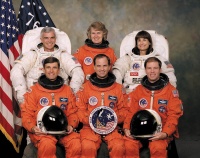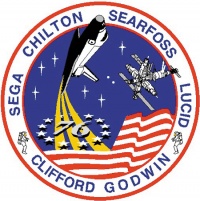STS-76
From The Space Library
 | |
| Organization | NASA-Office of Space Flight (United States) |
|---|---|
| Mission type | Human Crew |
| Launch date | March 22, 1996 |
| Launch vehicle | Space Shuttle |
| Launch site | Cape Canaveral, United States |
| COSPAR ID | 1996-018A |
| Inclination | 51.6 degrees |
| Experiments | Here |
| Alternate Names | 23831 |
| Additional Information | Here |
| Data Collection | Here |
| Payload Mass Up | 6753 kg |
| Payload Mass Down | 5480.91 kg |
| Orbiter | Atlantis |
| Lift Off Mass | 2,049,774.09 kg |
| Orbiter Weight at Liftoff | 111,975.00 kg |
| Orbiter Weight at Landing | 95,598.18 kg |
| Landed | Concrete runway 22 at Edwards Air Force Base, Calif. |
| Orbits of Earth | 145 |
| Orbital Altitude | 213 nautical miles (245 statute miles) |
Contents |
[edit] Crew
- Commander: Kevin P. Chilton
- Pilot: Richard A. Searfoss
- Payload Commander:
- Mission Specialist 1: Shannon W. Lucid - up only
- Mission Specialist 2: Linda M. Godwin
- Mission Specialist 3: Michael R. "Rich" Clifford
- Mission Specialist 4: Ronald M. Sega
- Mission Specialist 5:
- Payload Specialist 1:
- Payload Specialist 2:
ISS/Mir Crew Transport
[edit] Mission
STS 76 was a US shuttle mission launched from Cape Canaveral. The primary mission objective was the third docking between the Space Shuttle Atlantis and the Russian Space Station Mir. It included a crew transfer, an extravehicular activity (EVA), logistics operations and scientific research. Rendezvous and docking with Mir was scheduled to occur on flight day three using the same approach as previously used during STS-74. Docking occured between the Orbiter Docking System in the forward area of Atlantis' payload bay and the Docking Module installed during STS-74 on Mir's Kristall module docking port. The mission also featured a SPACEHAB module, middeck experiments, a Get Away Special (GAS) canister and a 6-hour EVA. Over 1,900 pounds (862 kilograms) of equipment are being transfered from Atlantis to Mir including a gyrodyne, transformer, batteries, food, water, film and clothing. Planned Experiments included the Mir Electric Field Characterization (MEFC) experiment, numerious European Space Agency's (ESA) Biorack life sciences experiments, the Queen's University Experiment in Liquid Diffusion (QUELD) experiment, the Optizone Liquid Phase Sintering Experiment (OLIPSE) and a Naval Research Laboratory (NRL) Get Away Special (GAS) payload Trapped Ions in Space (TRIS) experiment. TRIS measured low-energy particle radiation in the inner magnetosphere. Another experiment conducted on Mir during STS-76 was the Mir Wireless Network Experiment (WNE) which was launched on STS-74 in November 1995. It tested the first wireless client-server network in the space environment. The mission also included KidSat, a prototype of Earth viewing cameras and instruments that allows students in grades Kindergarden to Grade 12 (K-12) to see and direct the capture of pictures from space. Mission Specialists Godwin and Clifford perform a six-hour spacewalk on flight day six. They attached four experiments, known collectively as the Mir Environmental Effects Payload MEEP, onto handrails located on the Mir Docking Module. These experiments include the Polished Plate Micrometeoroid Debris (PPMD) experiment, the Orbital Debris Collector (ODC) experiment, and the Passive Optical Samples (POSA) I and II experiments.
[edit] EVA
Extravehicular Activity (EVA) conducted by Linda Godwin and Rich Clifford, 6 hours, 2 minutes. Godwin and Clifford attached four experiments, known collectively as MEEP, onto handrails located on Mir's docking module. They also detached a television camera from the outside of the Mir docking module to return it to Earth, and evaluated a variety of new spacewalking tools capable of being used on both the U.S. and Russian spacecraft.
[edit] Payload
Shuttle-Mir Mission 3; SPACEHAB/Mir 03; Kid-Sat; Shuttle Amateur Radio Experiment (SAREX) II, Configuration M; RME 1304 - Mir/Environmental Effects Payload (MEEP); orbiter docking system; RME 1315 - Trapped Ions in Space Experiment (TRIS); Extravehicular Activity Development Flight Test (EDFT) 04
[edit] Books about the Space Shuttle Program
Buy This Book Click here |
Buy This Book here |
Buy This Book Click here |
Buy This Book Click here |





